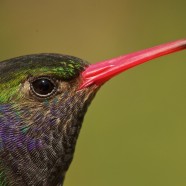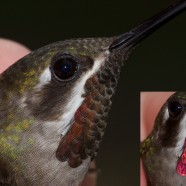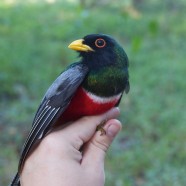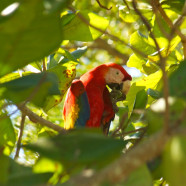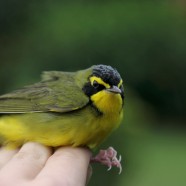Costa Rica: Finca Pura Vida
The last site we do research on is our home base which we call Finca Pura Vida. The Finca is on 10 hectares and backs up to a larger track of contiguous forest. The site has a good variety of different species and is particularly rich with Neotropical migrants. We do the majority of our Hummingbird banding research at the site because it has a healthy migrant population of Ruby-throated Hummingbirds (Archilochus colubris). We band resident hummingbirds as well and have recorded two out of range species. There is a diverse variety of other wildlife and we have noted a great diversity of fauna...
Read MoreLong-billed Starthroat (Heliomaster longirostris) by Sean Graesser
This is a Long-billed Starthroat (Heliomaster longirostris), another out of range species that Sean has been finding on the Nicoya peninsula. What he wanted to highlight here were the gorget feathers. These are the feathers located on the throat of this hummingbird and where males typically have their most colorful plumage. In most hummingbird species males develop these feathers as they age to be used for breeding displays with females. The gorget feathers actually reflect light due to their shape and the colors are not due to keratin based pigmentation. At different angles the light...
Read MoreElegant Trogon (Trogon elegans) by Sean Graesser
This is an Elegant Trogon (Trogon elegans), one of the two Trogon species that can actually occur in the United States. Two years ago we first observed a female at our site in Curu Wildlife Reserve. This species was normally not found this far south on the Nicoya Peninsula in Costa Rica. The next year we caught a male in our nets, the bird pictured. The first time we saw the female we chalked it up to a vagrant that might have gone too far down during a migration in search of a reliable fruit source. But with the male being caught the next year we are trying to figure out if it’s a species...
Read MoreCosta Rica: Curu Wildlife Reserve
The second site in our upcoming research trip to Costa Rica is at Curu Wildlife Reserve. It is a very unique site in all senses of the word. Curu was purchased in 1933 by Frederico Schutt and used for a number of years as a cattle ranch. Feeling the pressure of squatters and other financial strife the Schutt family looked to the Costa Rican government for help. In 1981 their land received protected forest status and in 1983 the Curu National Wildlife Refuge was created. Their property encompasses approximately 1500 hectares of which about 75 hectares is protected under the terms wildlife...
Read MoreCosta Rica: Cabo Blanco Nature Reserve
This is the first of many blog posts from new RTPI Affiliate Sean Graesser who carries out several active research and education initiatives in Central America along with RTPI President Twan Leenders. See more information about all of our tropical research and conservation work in the link above. Leading up to my departure to start our research season I thought I would introduce you to our sites and some of the work from the past field season. The three sites we conduct research at are: Cabo Blanco Nature Reserve, Refugio de Vida Silvestre Curu , and Finca Pura Vida. I will introduce each...
Read More



